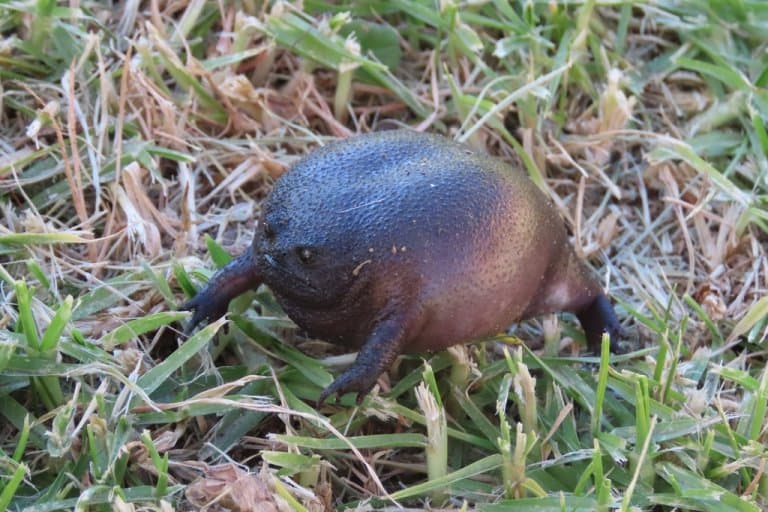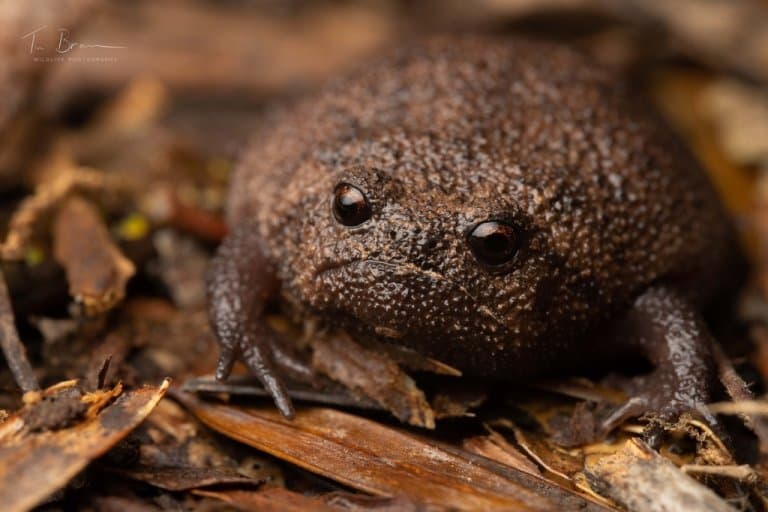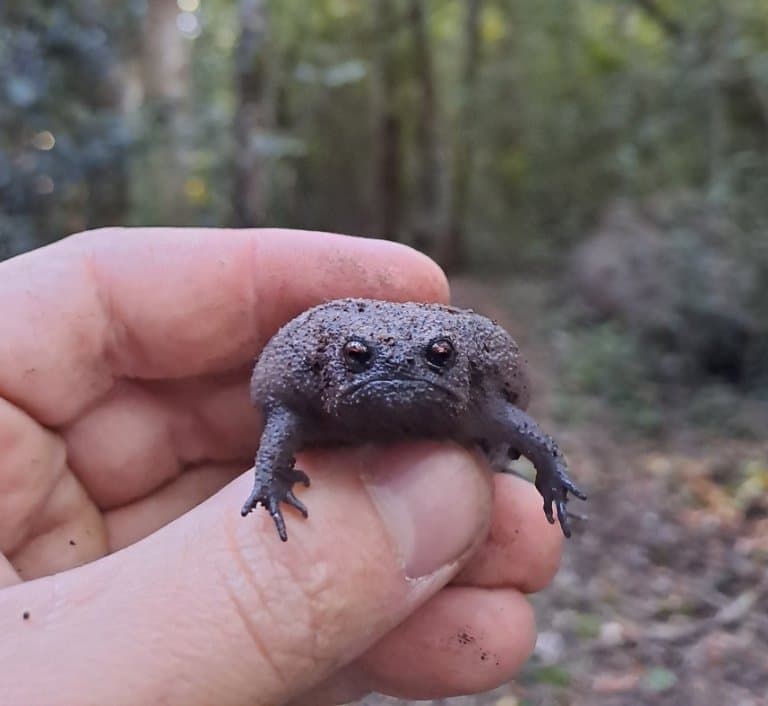Black Rain Frog Profile
High on the mountain slopes of the Cape Fold Mountains in Southwestern South Africa lives an unusual, yet delightful small burrowing frog species.
The black rain frog is so named due to its almost completely black colouration, but is also called the ‘plain rain frog’, ‘African rain frog’, or ‘Tsitiskamma rain frog’. As the name suggests, this animal is mostly active during the rainy season, remaining in underground burrows during drier periods.
These amphibians are extremely rounded in body shape, with shorts legs and a downward facing mouth, giving the impression the frog is constantly grumpy. They also have the ability to inflate themselves with air, to make their appearance larger to predators.
Black rain frogs are found in only one country on Earth, South Africa – and only across a very specific habitat in the Cape Fold Belt.

Black Rain Frog Facts Overview
| Habitat: | High altitude mountain forests and mountain fynbos (heathland) |
| Location: | Southwestern coast of South Africa |
| Lifespan: | Up to 15 years in the wild |
| Size: | 4-5 cm in length |
| Weight: | Around 6g |
| Color: | Usually dark brown or black in colour and covered with thousands of small bumps or tubercles |
| Diet: | Insectivorous, feeding on insects and their larvae |
| Predators: | Birds of prey, snakes and bush pigs |
| Top Speed: | 5 kph (3 mph) |
| No. of Species: |
1 |
| Conservation Status: |
Least Concern |
They are commonly found at altitudes much higher than 1,000m and tolerate relatively cold and wet seasons as well as surviving through much warmer, drier conditions.
Their preferred habitat is amongst the fynbos, a unique type of heathland found only in this part of the world. As black rain frogs are a burrowing species, they tend to prefer areas with sandy soil, which is easier to dig into.
Spending most of their time underground, this provides safety from predators as well as good access to moisture and possible prey.
As with most frog species, the black rain frog mainly feeds on insects, especially termites, ants, flies and crickets. They will also eat insect larvae that they have dug out of the soil as well as spiders, moths and other invertebrates they encounter.
Black rain frogs are almost entirely nocturnal, spending the daylight hours underground, although they do emerge during the day during breeding season or heavy rains.
The main predators of black rain frogs are snakes and raptors, however there is evidence that bush pigs will also feed on several of these frogs in a single night when the frogs are foraging in large numbers.
Black rain frogs of all sizes can be easy prey due to their lack of speed, however they are able to deter predators in several ways. They can inflate their bodies, increasing their size drastically and the bumps on their skin can appear poisonous to certain predators. If these methods fail, the black rain frog will dig itself into the soil before an attacker has a chance to strike.
Luckily for the black rain frog, most of the unique habitat where they are found is located within protected areas. This is crucial to the survival of the species as they are extremely susceptible to human activity such as construction and mining.
As with most amphibians, the black rain frog is an integral part of the ecosystem, preventing insect over-population as well as increasing nutrient flow through in the soil through their burrowing activities. The burrows the black rain frog dig also provide shelter to insects and other small animals.
Interesting Black Rain Frog Facts
1. Black rain frogs do not have skin covered in warts
They are covered in small bumps called ‘tubercles’, merely giving them a ‘warty’ appearance.
These bumps can appear poisonous to certain predators, although they aren’t! 1

2. The bumps on their skin keep their skin lubricated
Black rain frogs rarely drink water, instead they can absorb moisture through their moist skin. 2
3. They look like they are unimpressed at all times
Due to the shape of their mouth, black rain frogs look as if they are always grimacing, which has helped them become and internet meme.

4. They can make themselves appear 7 times larger
Black rain frogs can inflate their bodies with air to make themselves look far large than they are usually, to deter approaching predators as a defence mechanism.
They also use this unique ability to jam themselves in their burrows, so other animals can’t pull them out of their burrows due to their size.
5. Black rain frogs are found in only one, very specific area
These frogs live only on the mountain slopes in the Southwestern Cape of South Africa.
6. They can’t hop away, but they are expert diggers
They are unable to hop due to their body shape, and instead move ponderously by walking on their relatively short legs.
However when it comes to digging, these species are experts.
Scientists have recorded rain frogs disappearing in front of their eyes due to their ability to dig themselves under the soil in a few seconds. 3
7. Black rain frogs cannot swim
Unusually for frogs, the black rain frog is unable to swim and survives in areas with little to no open water sources.
Although they are able to float, these frogs will drown if they cannot reach land quickly.

8. They chirp in heavy rain, and breeding season
Due to their nocturnal nature and location, black rain frogs are rarely seen. However during rains or the breeding they produce high pitched chirps, with the sound filling the air when they call in large numbers.
During the breeding season, males attempt to attract females to their burrow by calling from inside a well-prepared, clean underground tunnel. As with most frogs, the black rain frog is a solitary animal, only coming together during the breeding season.
They do however tolerate living in close proximity to one another and where prey is abundant, several individuals may be found living in adjacent burrows.
9. Females stick males to their backs during matings
Due to their rounded body shape, mating is challenging and therefore rain frogs have evolved an ingenious method to make sure a male remains on the females back during mating.
Females secrete a sticky substance that glues the male to their back and this ensures that when she lays her eggs, the male is in position to fertilise the released eggs.
Females lay around 40 eggs in a depression within the burrow and after the eggs are laid, males take over the responsibility of protecting them. 4
10. Young black rain frogs are called ‘froglets’
Unlike aquatic species of frog, black rain frog eggs do not hatch into tadpoles. Instead, miniature versions of the adult form hatch, a process called direct development.
These tiny young frogs are called froglets and it is most likely that they are entirely independent of their parents as soon as they emerge from the nest burrow.

11. Males are much smaller than females
As with many frog species, males can sometimes measure half the size of females.
12. Some people belive that these frogs bring or stop the rains
As they call just before the rainy season, some tribes thought that the frogs determined the forthcoming weather. 5

13. The habitat type in which the live is a sanctuary to many other animals and plants
The protected fynbos habitat is also home to species of tortoise, mice, sunbirds and butterflies, to name a few. 6
Black Rain Frog Fact-File Summary
Scientific Classification
| Kingdom: | Animalia |
| Phylum: | Chordata |
| Class: | Amphiba |
| Order: | Anura |
| Family: | Brevicipitidae |
| Genus: | Breviceps |
| Species Name: |
Breviceps Fuscus |
Fact Sources & References
- Hewitt (1925), “Breviceps fuscus”, Amphibia Web.
- Channing Sargent, “Black rain frogs: burrowing and always in a bad mood”, One Earth.
- (2000), “Southern African Frog”, Amphibians.
- Stuart V. Nielsen (2018), “Multilocus phylogenetics in a widespread African anuran lineage (Brevicipitidae: Breviceps) reveals patterns of diversity reflecting geoclimatic change”, Wiley Journal of Biogeography.
- , “Black Rain Frog”, Our Breathing Planet.
- Ryan Tippett (2022), “Plain Rain Frog (Breviceps fuscus)”, Biodiversity & Development Institute.
